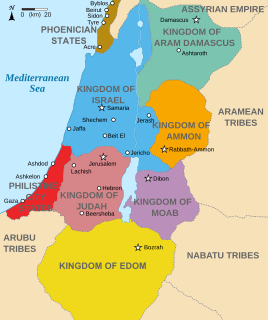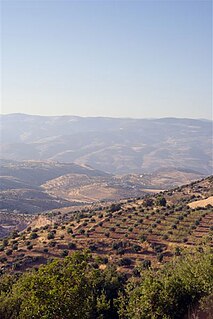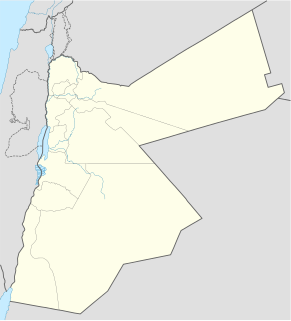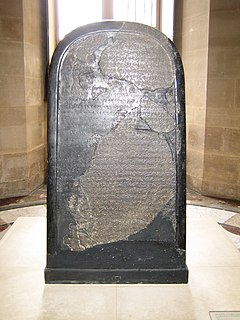 W
WMoab is the name of an ancient kingdom whose territory is today located in the modern state of Jordan. The land is mountainous and lies alongside much of the eastern shore of the Dead Sea. The existence of the Kingdom of Moab is attested to by numerous archaeological findings, most notably the Mesha Stele, which describes the Moabite victory over an unnamed son of King Omri of Israel, an episode also noted in 2 Kings 3. The Moabite capital was Dibon. According to the Hebrew Bible, Moab was often in conflict with its Israelite neighbours to the west.
 W
WThe Balu' Stele is a basalt stele with an inscription and relief panel. It was discovered in 1930 north of the city of Al-Karak and is thought to date to 1309-1151 BCE, belonging to the Kingdom of Moab.
 W
WAl-Karak, known in the Kingdom of Jerusalem as Kerak, is a city in Jordan known for its Crusader castle, the Kerak Castle. The castle is one of the three largest castles in the region, the other two being in Syria. Al-Karak is the capital city of the Karak Governorate.
 W
WDhiban, known to the Moabites as Dibon, is a Jordanian town located in Madaba Governorate, approximately 70 kilometres south of Amman and east of the Dead Sea. Previously nomadic, the modern community settled the town in the 1950s. Dhiban's current population is about 15,000, with many working in the army, government agencies, or in seasonal agricultural production. A number of young people study in nearby universities in Karak, Madaba, and Amman. Most inhabitants practice Islam.
 W
WAccording to the Book of Judges, Eglon was a king of Moab who oppressed Israel.
 W
WThe El-Kerak Inscription was discovered in 1958 in Jordan, near the El-Kerak wadi. It is a basalt inscription fragment measuring 12.5 centimeters (4.9 in) high by 14 centimeters (5.5 in) wide. The inscription has been dated to the late ninth century BC. The inscription is known as KAI 306.
 W
WGilead or Gilad is the name of three persons and two geographic places in the Bible. Gilead may mean 'hill of testimony'. If this is the case, it is likely derived from גלעד gal‛êd, which in turn comes from gal and ‛êd. There also exists an alternative theory that it means 'rocky region'. It is now within the Kingdom of Jordan.
 W
WThe Bani Hamida -nomadbedouin tribe that controlled much of the land East of the Dead Sea before the establishment of the emirate of Transjordan.
 W
WThe heresy of Peor is an event related in the Torah at Numbers 25:1–15. Later biblical references to the event occur in Numbers 25:18 and 31:16, Deuteronomy 4:3, Joshua 22:17, Hosea 9:10; Psalm 106:28. New Testament references are found in 1 Corinthians 10:8 and Revelation 2:14.
 W
WHeshbon were at least two different ancient towns located east of the Jordan River in what is now the Kingdom of Jordan, historically within the territories of ancient Ammon.
 W
WLot was a patriarch in the biblical Book of Genesis, chapters 11–14 and 19. Notable events in his life include his journey with his uncle Abram (Abraham) and his flight from the destruction of Sodom and Gomorrah, during which Lot's wife became a pillar of salt, and Lot was made drunk by his daughters so that they could have children with him.
 W
WMadaba is the capital city of Madaba Governorate in central Jordan, with a population of about 60,000. It is best known for its Byzantine and Umayyad mosaics, especially a large Byzantine-era mosaic map of the Holy Land. Madaba is located 30 kilometres south-west of the capital Amman.
 W
WKing Mesha of Moab was a king of Moab in the 9th century BC, known most famously for having the Mesha Stele inscribed and erected at Dibon. In this inscription he calls himself "Mesha, son of Kemosh-[...], the king of Moab, the Dibonite."
 W
WThe Mesha Stele, also known as the Moabite Stone, is a stele dated around 840 BCE containing a significant Canaanite inscription in the name of King Mesha of Moab. Mesha tells how Chemosh, the god of Moab, had been angry with his people and had allowed them to be subjugated to Israel, but at length, Chemosh returned and assisted Mesha to throw off the yoke of Israel and restore the lands of Moab. Mesha describes his many building projects. Some say it is written in the Phoenician alphabet, but others say it is written in the Old Hebrew script, which is closely related.
 W
WOrpah is a woman mentioned in the Book of Ruth in the Hebrew Bible. She was from Moab and was the daughter-in-law of Naomi and wife of Chilion. After the death of her husband, Orpah and her sister-in-law Ruth wished to go to Judea with Naomi. However, Naomi tried to persuade both Ruth and Orpah to return to their people and to their gods. Ruth chose to remain with Naomi, however, Orpah chose to return to her people and her gods..
 W
WThe Book of Ruth is included in the third division, or the Writings (Ketuvim), of the Hebrew Bible; in most Christian canons it is treated as a history book and placed between Judges and 1 Samuel.